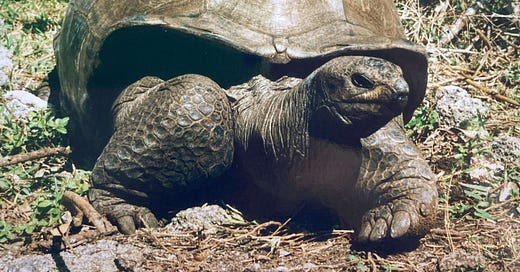Conservation in slow motion
Could a tortoise help Mauritius win a conservation race (3 minute preview, 7 minute read)
Every morning, as my dog Donna sniffs the latest smells at my local park, I walk past a couple of young horoeka, or lancewood, trees. Their narrow, brown leaves hang downwards, as if the plant is wilting. Even at the peak of health, a young lancewood looks half-dead. Eventually, the lancewood grows adult leaves, which are bright green and bear little resemblance to the leaves of the young plant. But it won’t do that until it’s a couple of metres tall at least.
One theory for the two different leaf types is that they’re an adaptation to moa browsing. In the forest, the leaves of a juvenile lancewood are hard to spot, and don’t look very nutritious if you do manage to spot them. There are other theories, but I like the moa theory because it fits with the lancewood’s cousins in Mauritius, which have the same habit.
I first met lancewood’s Mauritian cousins on an island called Île aux Aigrettes. It’s about the size of Matiu/ Somes Island in Wellington Harbour, just 26 hectares. But it’s crucially important for conservation in Mauritius, because it’s one of very few predator-free nature reserves. While I was in Mauritius, one of my jobs as a ‘volunteer consultant’ was to review the weed control which had been done on the island over the previous 20 years and draft a new weed management strategy. To do that, I needed to spend time on the island, and I was lucky enough to spend a couple of weeks there.
Île aux Aigrettes is not, at first glance, the most appealing place. It’s just under a kilometre off a couple of lovely white-sand beaches in the south-east of Mauritius, surrounded by turquoise water and coral reefs. But the island itself is a lump of jagged, razor-sharp coral rock. There’s not a grain of sand in sight. At the end of my working day, I used to snorkel around the island, but the only way to get in and out of the water was from the concrete jetty.
During World War Two, the British had a military base on Île aux Aigrettes. Despite their efforts, some of the native forest was still surviving when it became a nature reserve in 1965. Human occupation left a legacy of feral cats, rats and shrews, and as well as a lot of weeds; the cats and rats were eradicated, and the critically engangered pink pigeon was introduced to the island. The shrews remained – although there have been various attempts, nobody had yet worked out how to eradicate them. At the time I visited, there were also still plenty of weeds.
The forest canopy on Île aux Aigrettes was dominated by one of the Mauritian species of ebony, and in the undergrowth was a species related to New Zealand’s lancewood, known by Mauritians bwa de boeuf, which means “beef tree”. There was another familiar tree too, known as bwa de rat, which I recognised as a close cousin of New Zealand’s Coprosma species. Nobody ever explained to me what these trees had to do with beef or rats. Both of them were small trees which had different leaves in their juvenile and adult forms. Bwa de rat was particularly lovely in its juvenile form – the leaves were mottled in green and yellow, with a red stripe down the middle. Once they reached a little over a metre tall, they converted to their adult leaves, which were simply green.
The theory about both bwa de rat and bwa de boeuf is that the leaf patterns on the juvenile foliage made them hard for the main browsing species – giant tortoises – to see. The adult foliage is produced at a height just above where a tortoise can reach. It makes an interesting contrast with the lancewood, which is twice as tall before it produces adult foliage, just high enough to avoid the beak of a moa.
Just like New Zealand, Mauritius never had any native mammals except bats. Its browsing animals were giant, flightless pigeons, known as dodos, and giant tortoises. The dodo, of course, became an icon of extinction, giving us the saying “as dead as a dodo”. The Mauritian species of giant tortoises went the same way.






